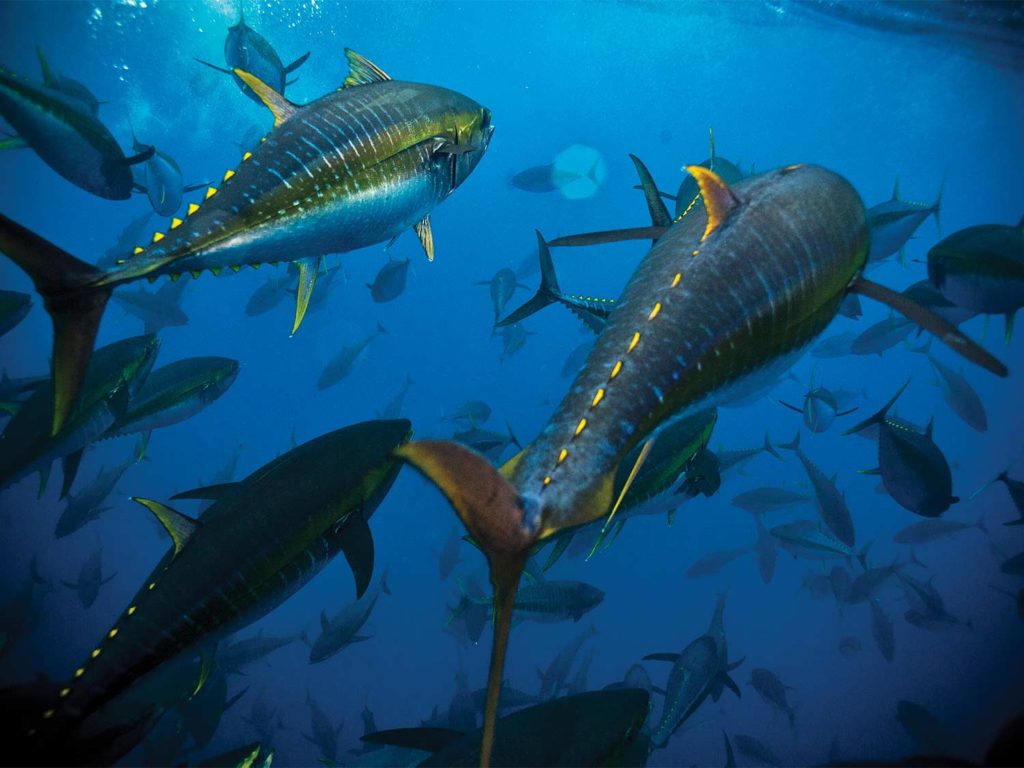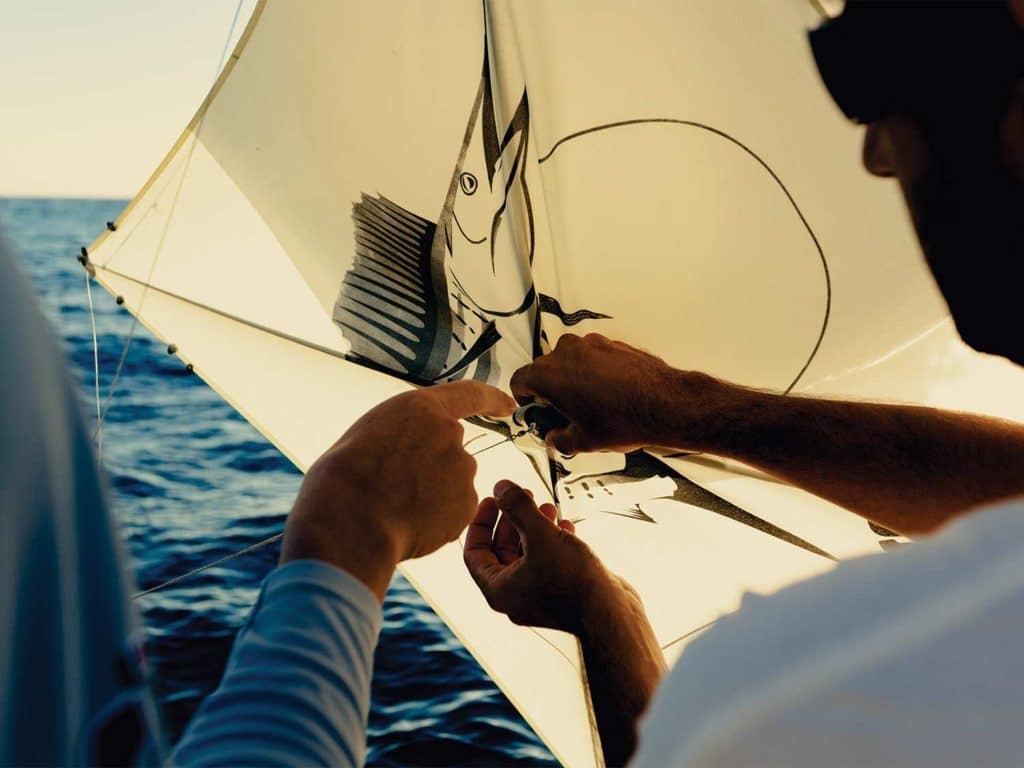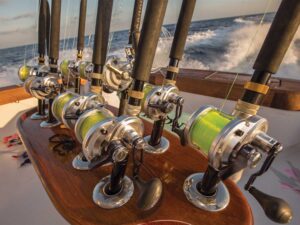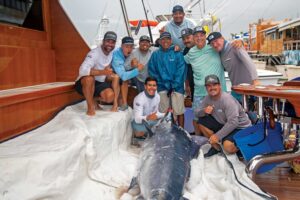
If there is one thing we know about fishing for yellowfin tuna in the Northeast, it’s that the bite is always changing. As with all fishing seasons, if you aren’t prepared to adapt as it progresses, it will eventually make the difference between whether you put together a catch—or not. As the season wanes, we need to constantly change locations, adjust our tactics, and adapt our tackle based on where the tuna are biting if we want to produce.
Watch: The bonito strip is a deadly teaser for all species, including tuna.
Fish Where the Fish Are
The early season has become the best time to target yellowfin tuna. Tuna generally school up tight together in big numbers on the leading edge of the warm-water Gulf Stream eddies, temperature breaks and water-color changes this time of year. These conditions make locating your target species a little more painless, especially if you can utilize a dependable sea-surface-temperature service such as ROFFS, FishTrack, RipCharts or Sirius XM Marine’s Fish Mapping. A good SST service will help find—and follow—these conditions and is nearly imperative to your success when fishing the middle Atlantic, not just at the beginning of the season, but throughout.
The canyons offshore are typically a long run, ranging from 50 to 100-plus miles, depending on your location on the Eastern Seaboard. Many mid-Atlantic fishermen hope and pray that the tuna find their way from the continental shelf inshore to the local lumps and humps that are scattered along the coast in 20 to 40 fathoms. This makes tuna much more accessible, especially for small boats.
This mini migration begins to happen in the summer as the water warms up, and many yellowfins find their way inshore and take up residence throughout the summer season, munching on sand eels and other assorted baitfish. While we do catch tuna on the troll inshore, chunking, jigging, and kite-fishing have become the best way to target them because their cautious nature and extraordinary eyesight make it easy to put two and two together.
Trolling
You can catch tuna trolling all season long in the mid-Atlantic, but earlier in the season is best. When trolling the canyons, using a mixed-bag spread of skirted ballyhoo and spreader bars on 50-pound tackle sets you up to capitalize on the fish that exhibit a less-wary character; plus, you will be ready for the monsters that jump on you. You can absolutely scale down your tackle—terminal and otherwise—if you wish, but keep in mind that it’s this time of year when the bigeyes, giant bluefins and big blue marlin are around, and you don’t want to be caught undergunned.
When it comes to trolling for tuna, the more lines you have in the water, the better. On the boats I work on, we pull anywhere from 11 to 14 lines, depending on what the sea conditions allow. While more lines mean more hookups when you run over a school of hungry tuna, I always stress to work with only what you can effectively manage. Once hooked up, be sure to keep the boat in gear and jig any line that doesn’t have a fish on it to make it easier for the tuna to notice your bait. Stay in gear for at least 30 seconds, or until you have a few on, pulling back the throttle once you get settled in, making sure to keep the fish tight by bumping the boat in and out of gear.
Chunking
For me, a day of chunking the inshore lumps usually means bringing a minimum of four or five flats of butterfish (some used for chunks and some for hook baits), one flat of sardines (primarily used whole for hook baits), one flat of squid (also used for hook baits), and any live bait I can get.
The basic idea of chunking is simple: Set up your drift or anchor your boat and start throwing chunks of cut bait overboard, one handful at a time, every 30 seconds to create a chum line. The hungry tuna will find you by following this offering all the way to your waiting hook baits. Sounds simple enough, right? Well, while it is a fairly standard way of fishing, there are many tricks you can use to catch fish more consistently.

Leader diameter, tackle size and bait placement are key when chunking for tuna. Because of tuna’s keen eyesight, using a leader that is too heavy will cause them to turn up their nose at your bait. I usually start with 40-pound-test fluorocarbon leader, but if I notice the fish on my sounder or in my chunk line aren’t biting, I’ll scale down to 30- or even 25-pound. Although doing so will make landing these fish more difficult, using your best finesse will help to keep them from breaking off and will get them to the gaff.
Because your bait is slow-moving on the chunk, the tuna can really home in on it and see that something “isn’t quite right.” Therefore, you need to bury the hook in the bait so it can’t be easily seen. It is also important to place your baits in the chunk line, not away from it. Similar to yellowtailing in the Florida Keys, feed out your baits at the same speed as the chunks, letting them drift freely and naturally.
This method will net you the most bites, especially when using lightweight rods, such as 15- to 30-pound-class, and lighter drag. Spooling the reels with 50- to 65-pound braid or 30- to 40-pound mono will get the job done, and be sure to have plenty of pre-tied 25- to 40-pound fluorocarbon leaders with 4/0 to 7/0 circle hooks on hand.
Read Next: Check out our review of popular handheld electronics.
Kites and Vertical Jigs
One tool you don’t want to go to the chunking grounds without is your kite. While using live baits is the preferred method when fishing with kites, they can still be effective with dead baits. Hooking a squid through the mantle or a sardine through the back and allowing it to slap on the surface will get a tuna’s attention. The nice thing about using a kite is that the leader is out of the water, allowing you to get away with using a heavier leader and upping your odds of landing your fish. However, it will require constant attention to keep your bait in the strike zone as it dances on the surface with light wind gusts.
Tuna on the inshore grounds also creates a great opportunity to catch them on jigs. It is so much fun, and some days that will account for the majority of your catch. With so many jigs on the market, just find what works best for you. I’ve found that it’s hard to beat a good ol’ hammered diamond jig: Drop it to the bottom and work it through the water column with a rod built especially for jigging and a high-gear-ratio reel. Using a heavy-action rod—or a heavyweight reel—will wear you out unnecessarily.
Each year the big question is: Where will the tuna be staged throughout the season? Every year is different, but they are bound to be somewhere, and if you follow the inshore and offshore waters with satellite imagery and get good fishing reports, you’ll find them. And when you do, fire up the grill and sharpen your sashimi knife. I’ll be standing by for the dinner invite.







